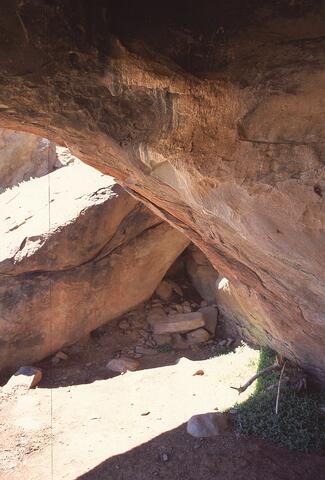Identificatie
referentie code
Titel
Datum(s)
- 12/12/2001 (Vervaardig)
Beschrijvingsniveau
Omvang en medium
Context
Naam van de archiefvormer
Biografie
Brief description of site: RSA VES1 is, in fact, a site complex with at least 5 different Rock Art sites. This site complex is located on a prominent sandstone outcrop. Each site takes the form of a scalloped, circular shelter, varying in size from 4 m long to over 20 m. The river is less than 20 m from the sites, which face out over a vast plain. Weathering in this part of the world is severed, resulting in the circular shelters, formed by layers of sedimentary rock exfoliating. Most of the sites thus have a deeper, inner shelter.
Because relatively few people have been to this site, the archaeology is still in good condition. Present as a surface scatter within the shelter are numerous hornfels (also known as indurated shale or lydianite) lithics (stone tools), vast numbers of ostrich eggshell pieces, bone and at least half-a-dozen lower grindstone patches as well as a similar number of upper grindstones. The stone tools include side and end-scrapers such as were used to prepare leather for clothing. An adze shows that woodworking took place in the shelter and the numerous flakes indicate multi-purpose use. Cores, chips and chunks are present and suggest that stone tools were made on-site. The hornfels raw material is abundant in the area. The ostrich eggshell fragments are both from beadwork and from whole eggs that were used to store various things such as water, ochre and medicines. The bone fragments - some burnt - show that people prepared food within the shelter. The quantity of artefacts as well as their distribution suggests that this was an important living area for both the San (Bushmen) and for later groups such as Khoe (Khoi) herders. The larger tools belong to the Khoe herders and the finer tools to the Bushmen hunter-gatherers; as a general rule. Interestingly, the artefacts are not confined to the rock shelters, but are dispersed over a wide area.
Brief description of art: There are at least 50 individual rock paintings in the five shelters, though there would have been many more on the exfoliated sandstone walls. These rock-paintings fall into two distinct rock-art traditions:
San (Bushman) rock-paintings: There are very few surviving San (Bushmen) rock paintings made by people who lived a gathering and hunting way of life and who followed a structured, seasonal round, moving across the landscape to favoured locations. The reason for this moving about was both practical - to follow seasonally available food resources - and spiritual, as the San believed they had to regularly visit and maintain certain special or scared places on the landscape. RSA VES1 is one such place. There are a few red animals - perhaps eland (Tragelaphus oryx) - surviving near the base of Site 5. Patches of deep red ochre - Bushman rock paintings here are made in deeper, finer grained pigment than the more granular and brighter Khoe pigments - that cannot now be distinguished to form, hint at a once-substantial Bushman rock painting presence.
Khoe (Khoi) rock-paintings: Distinct from the San rock-paintings - which were made with a brush) are the red, white and yellow finger-painted geometric motifs. There are also some rudimentary representational motifs in red that look like human figures and perhaps horses. Though not yet well-understood, these rock-paintings are the work of Khoe (Khoi) herders who moved into this part of southern Africa some 1 000 years ago with their cattle and sheep. They had good relations with the San and there was a good degree of intermarriage and cultural transmission. Khoe herders lived in this area until Historic times and perhaps as late as the early 20th -century. Though new to science, this new rock-art tradition promises much and RSA VES1 will be a key site in this new research. Unlike the San, odd locations such as rock shelter ceilings and inner recesses were favoured paint surfaces. The paint used is a thick, coarse slurry that does not penetrate into the rock but adheres to the surface and has a bright, chalk-like appearance when fresh.
Naam van de archiefvormer
Biografie
Nationality: South African
Created by: willem
Created on: 11/03/2003
Naam van de archiefvormer
Biografie
archiefbewaarplaats
Geschiedenis van het archief
Directe bron van verwerving of overbrenging
Inhoud en structuur
Bereik en inhoud
Waardering, vernietiging en slectie
Aanvullingen
Ordeningstelsel
Voorwaarden voor toegang en gebruik
Voorwaarden voor raadpleging
Voorwaarden voor reproductie
Taal van het materiaal
- Engels
Schrift van het materiaal
Taal en schrift aantekeningen
Fysieke eigenschappen en technische eisen
Original size: 35mm

